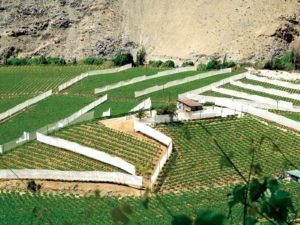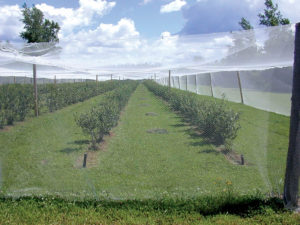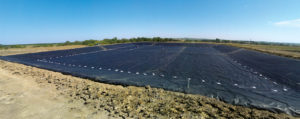
As Mother Nature persists in her fickle and sometimes destructive ways, manufacturers of agricultural fabrics and fabric products report strong and growing demand in many areas.
The agricultural arena isn’t for the faint of heart; just ask anyone who earns a living by keeping us supplied with food. Too many things can go wrong—too much or too little rain, hail storms, freezes, withering heat, insects, diseases and voracious birds and pests—all of which can result in real calamity for growers and producers. But it’s not as if they’re entirely defenseless in their battles with Mother Nature. Thanks to manufacturers of fabric agricultural products like covers, netting, barriers, shade systems and other aids, they have effective tools at their disposal to help them stand up to the various challenges threatening production. And as climate change exerts an ever-greater impact on these markets, fabric agricultural products are playing an ever-greater role.

Consider Tek-Knit Industries Inc. Located in Mont-Royal, Quebec, Canada, the specialized industrial fabrics manufacturer provides products to a variety of markets, including the agricultural and horticultural industry, says Jason Storozum, who handles sales and marketing for the company. The company’s output includes fabrics and netting for vineyard and berry crop protection, keeping insects, birds and animals at bay; hail netting, which also diffuses heavy rain and can keep out some insects; agricultural fencing, deployed as a boundary against animals and people, wind and snow; tree wraps, designed to prevent damage to trees and certain plants during the winter; and shade cloth, used primarily in warmer climates to protect crops from the harsh effects of the sun.
“Our insect netting has been experiencing higher demand from berry growers, mainly due to the increased presence of the spotted wing drosophila (SWD) across North American and abroad,” says Storozum. “This aggressive type of fly invades berry crops and in many cases causes high losses in production.”
The netting, constructed from Tek-Knit’s 80 gram fabric, provides for the total exclusion of any insect over .6mm in size, protecting the berries from the SWD, the crop’s primary enemy. It affords additional protection from heavy rain, wind, birds and other elements, while keeping shade at a minimum because of its clear color.
In the shade
The market for Tek-Knit’s shade cloth is also strong, influenced by changes in global weather patterns, Storozum says. “The more severe the weather gets, the higher the demand for protection from it,” he says. “Producers see the real dollar value of crop protection management.”

GALE Pacific Ltd.—headquartered in Melbourne, Victoria, Australia, with U.S. headquarters in Altamonte Springs, Fla.—is a global marketer and manufacturer of branded screening and shading products for domestic, commercial and industrial applications, including agriculture and horticulture. Among the company’s offerings are Premium Hortshade®, used to protect crops as well as people and assets, says Gretchen Fix, vice president of marketing. The knitted shade fabric, using 100 percent high-density polyethylene (HDPE), is available in a range of weights and sun-block factors, from 29–77 percent, and resists sun damage, water absorption and rotting.
The shade fabrics, along with the company’s commercial netting fabrics (also constructed from HDPE), provide protection from the elements, birds and pests and also help create “micro-climates,” Fix says. “We’ve also factored in that different crops require different PAR (photo-synthetically active radiation or photosynthesis) for plant growth. So our range includes different fabric weights and aperture sizes, allowing for flexibility.”
According to Fix, there’s a global demand for the knitted and netting products, driven by end-use benefits like broader growing windows, better quality produce, a more regulated growing environment and more consistent product yields. And shade cloth doesn’t just keep crops from harm; it’s also being used to protect livestock, says Michael Ciferri Jr., owner of Cosner Manufacturing, a Lake Wales, Fla.-based cut-and-sew operation specializing in animal shade and produce harvesting products.
“Heat stress can reduce milk production, stall breeding and actually kill cows and hogs if not mitigated,” he says. “There’s no end to heat, so this product has a healthy future. Demand is also high because of the custom sizes required, which means overseas manufacturers cannot take this business from us.”
Cosner’s animal shade fabrics are constructed from a woven polypropylene 73 percent flat tape yarn. A heavier duty version (at 88 percent, this is more like a trampoline fabric) is also available, as is a knitted version (70 percent). Products have a 10-year life expectancy if hung correctly, Ciferri says.
Covering up
Dairy farmers and those with feeder cattle operations aren’t just interested in protecting their cows; they also need to safeguard their silage (feed), says Tom Stoebner, director of market development for Raven Industries Inc. Headquartered in Sioux Falls, S.D., the company manufactures and supplies fabric-reinforced flexible films and sheeting to a variety of markets, including agriculture and environmental containment. Among the fabric-reinforced products slated for agriculture are custom grain covers, oxygen barrier silage covers and agricultural waste containment liners. Geomembrane liner and cover (extrusion/cast fabric reinforced) products include landfill covers, pond liners and wastewater lagoon liners.

Protecting silage has become critical in the face of low milk prices and high operating expenses, according to Stoebner, who says customers are deploying the company’s FeedFresh® fabric-reinforced oxygen barrier silage cover to prevent rainfall and oxygen from reaching the feed.
“Oxygen promotes the growth of aerobic organisms, which cause spoilage of valuable feed. Rainfall depletes the organic acids that are needed to help prevent the growth of decomposing organisms,” adds Stoebner. The FeedFresh covers are in high demand.
Raven also produces the GrainMax™, a fabric-reinforced grain cover system. “Temporary grain cover systems continue to be in demand due to limited conventional grain storage space,” Stoebner says. “This is especially true in years with record crops, limited rail capacity and low market prices.”
For silage and grain covers, Raven relies on high-tenacity, multi-filament fibers, forming a diagonal scrim pattern as the product is laminated.
“The internal fabric/scrim reinforcements of our Dura-Skrim® laminated materials are customized to meet performance expectations varying from open to very tight laid or knit configurations,” says Stoebner. “Depending on application requirements, we can offer textured anti-skid surfaces for enhanced safety. Seven co-extruded outer layers provide a barrier to oxygen, VOCs and other potentially harmful chemicals.”
GALE Pacific uses polyfabrics for its grain storage and protection products, as well as for water management, water tank liners, ground sheets, shelter structures and greenhouses. One such fabric is Landmark®, sold in the company’s Australian market and widely utilized for grain storage, says Fix. She says customers are on the hunt for premium fabric products.
“They want to use products they can trust, that have stood the test of time,” Fix says. “Replacing fabric that has prematurely failed can be costly on a number of fronts. High-quality fabrics can provide peace of mind as well as consistent performance for a number of years.”
Pamela Mills-Senn is a Long Beach, Calif.-based freelance writer.

Consumers have become much more interested in knowing where their food comes from and how it’s produced, inspiring a burgeoning interest in backyard and urban gardening. The trend has wide and growing appeal for sustainability-focused consumers. Along with reducing carbon footprint and creating green spaces, backyard/urban gardens provide people with a strong measure of control over what goes onto their plates and into their mouths—all factors contributing to the popularity of the company’s geodesic greenhouse domes, says Asha Deliverance, owner of Pacific Domes Inc. Located in Ashland, Ore., the company manufactures event, shelter, playground, biosphere and greenhouse domes.
“The advantage of domes is that the airflow is circular,” says Deliverance. “They shed rain, snow and water and are very strong structures, standing up well against even hurricane-force winds.”

44-foot geodesic greenhouse dome from Pacific Domes utilizes a translucent vinyl laminate polyester over a frame of steel tubing.
The domes also support food-growing towers and can be used for aquaponics: raising fish and growing plants in the water in a single integrated system in which the fish waste fertilizes the plants and the plants filter the water in which the fish live.
“This movement is really growing,” says Deliverance of aquaponics. “The oceans are so polluted and people are very suspicious of farm-raised fish. And the fishing industry is so compromised, with fewer species and a lack
of abundance.”
The domes use a translucent vinyl laminate polyester fabric (Herculite® Translucent T13) over a steel tubing frame. The fabric is UV protected, fire-retardant and will last about 10 years.  The company offers its customers—mostly homeowners but sometimes a school or university—standard kits, although most of what they do is custom. People can install the domes themselves, although for larger ones they’ll sometimes hire the company’s team to do the job.
The company offers its customers—mostly homeowners but sometimes a school or university—standard kits, although most of what they do is custom. People can install the domes themselves, although for larger ones they’ll sometimes hire the company’s team to do the job.
“Urban gardens are the wave of the future,” says Deliverance. “There’s a very big market for backyard food supplies.”
The challenges associated with the agricultural arena have required no small amount of foresight from manufacturers of fabric agricultural products. We asked our sources to tell us what they see happening in the field in the future.
Improved functionality
“Ongoing research is being conducted to improve the functionality of agricultural products to enhance their benefit to the market. This includes looking into ways we can further improve product yields and help to safeguard against plant disease without the need to use pesticides or herbicides,” says Gretchen Fix, vice president of marketing for GALE Pacific Ltd.
Continued scrutiny
“In our business of agricultural plastic film, lower-priced agricultural commodities present both challenges and opportunities. Ag markets are still seeing close-to-record yields and production, and with every dollar counting for producers, our value-added products help preserve those assets. Going forward, producers will continue to scrutinize spending and look to cut costs, so it’s vital we continue to emphasize and communicate the value proposition of our products,” says Tom Stoebner, director of market development for Raven Industries Inc.
Greater diversification
“Citrus is dying and we’ve been diversifying as quickly as possible. The industry is doing the same thing. They’re trying to plant peaches, blueberries and other produce in place of citrus, but it takes time,” says Michael Ciferri Jr., owner of Cosner Manufacturing. “It’s been a steady slide for about 10 years and in the last few years our bag sales have dropped drastically. We’re focusing on shade for animals; that demand will continue and doesn’t change much from year to year.”

When Cosner Manufacturing started operations 60 years ago, the Lake Wales, Fla.-based company specialized in produce harvesting bags, particularly citrus picking bags for the Florida orange juice industry, says owner Michael Ciferri Jr. But this market is “in big trouble,” he says.
“When I purchased this business 14 years ago we sold 20,000 citrus picking bags per season. Last year we sold 4,000,” says Ciferri. “This is partly because there are so many alternatives to orange juice. But mostly it’s because of the citrus greening disease, which has been wiping out citrus groves so fast and with no cure in sight.”
Adding to the woes is that the industry cannot find local laborers to do the picking and must rely primarily on agricultural visa workers from Central America to do the work, which can result in labor shortages. Then there’s Brazil.
“Brazil will take over the U.S. citrus market; if we do a free-trade agreement with them, it will be an end to U.S. fruit juice,” says Ciferri. “They’ve been taking over U.S. processing plants and at some point, due to labor costs in the U.S. compared to Brazil, the fruit will be picked in Brazil and processed in the U.S.”
Consequently, along with diversifying their offerings—Cosner has long offered animal shade products and is intensifying the focus on these items as well as branching into non-related products like golf cart parts and “monkey hammocks.” For the first time this upcoming season the company won’t make bags for stock. Instead, the 18-ounce vinyl bags will be made to order.
 TEXTILES.ORG
TEXTILES.ORG


